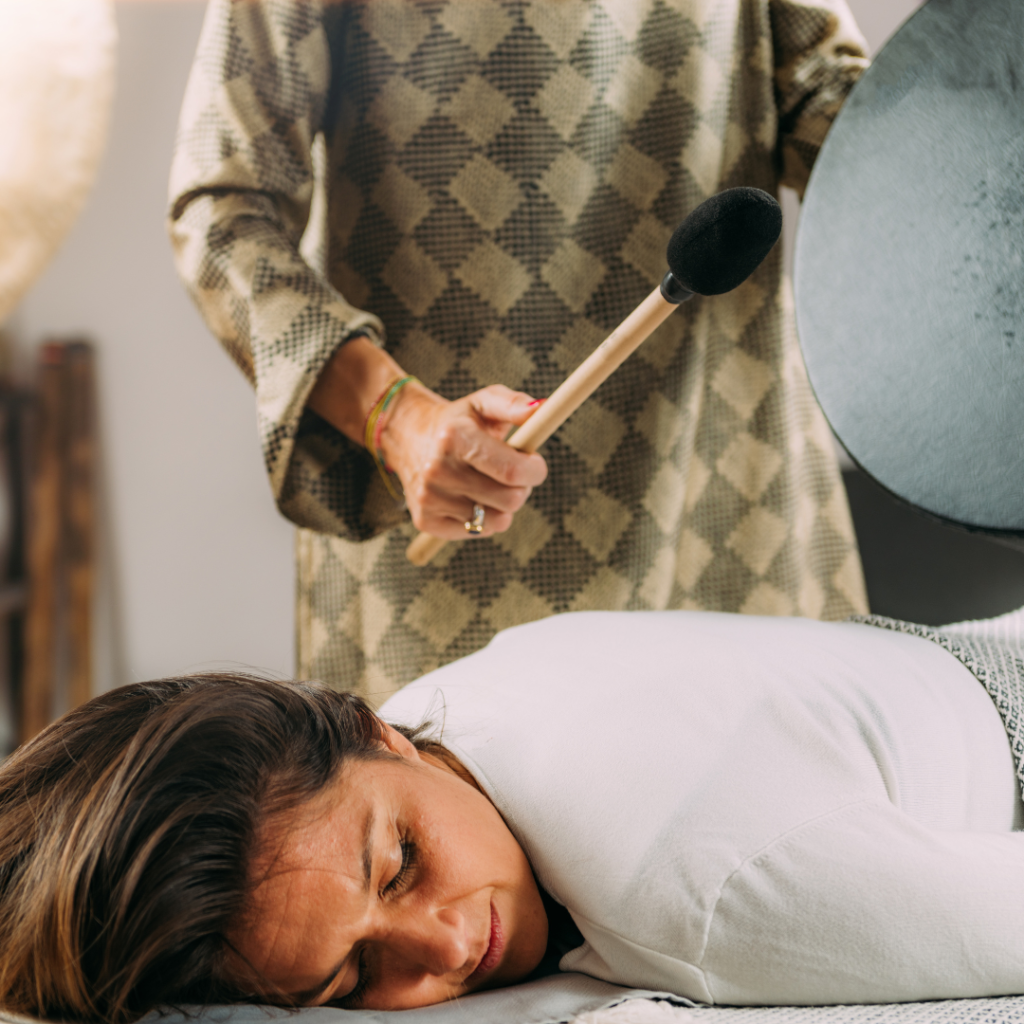
Sound healing, an ancient practice with roots stretching back through centuries, has experienced a resurgence in popularity as more individuals seek holistic approaches to health and wellness.
This comprehensive blog post delves into the fascinating world of sound therapy, exploring its historical origins, the scientific principles that underpin its effectiveness, and the myriad benefits it offers. We’ll also discuss potential side effects and set realistic expectations for those considering a sound healing session.

Sound healing is a wellness practice that combines the use of sounds, music, and instruments to promote health and well-being. The sound waves produced during a sound healing session are intended to balance and harmonize your body’s energy, as well as reduce emotional distress.
This ancient practice relies on sound vibrations, which can have a powerful impact on your mind and body. Sound healing can help facilitate a relaxed state by slowing down brain waves. This immersive wellness therapy can also be used for dealing with certain physical or mental health conditions.
Sound therapy comes in several shapes and forms. You might find that you resonate with certain instruments or techniques more than others. Some of the most common techniques are:
The history of sound healing is ancient and part of many cultures around the world. From singing bowls to drums to the didgeridoo, music has long held power over human minds and spirits.
Singing bowls in Tibet, Nepal and India were thought to promote healing and relaxation. The metal bowls were tapped or rubbed with wooden mallets to produce vibrational sounds for spiritual or healing ceremonies.
Several civilizations throughout ancient Africa, Asia, and the Middle East used rhythmic or shamanic drumming between 1,000 and 500 BC. Fast-paced drumming (4-7 beats per second) was used to shift states of consciousness and channel deities. Drumming was used to communicate over long distances as well, and eventually found its way to Rome and Greece between 200 and 150 BC.
Another ancient instrument that has recently sparked interest as a sound healing mechanism is the didgeridoo. It was used by indigenous Australians as part of cultural and spiritual ceremonies and likely dates back 1,000 years.
Gong making goes back to 4,000 BC and some evidence suggests it may have even taken place in 16,000 BC. They were used in ancient Egyptian, Greek, and Roman civilizations, as well as in ancient China. Their primary purposes were for communication, shamanic healing, and celebration.
These instruments and sound therapy techniques are still in use today. The twentieth century saw a renewed interest in sound healing and now, you can easily find sound bath sessions.


The basic premise of sound healing or sound baths is that certain frequencies can slow down brain waves, helping induce a more relaxed state. To understand how sound healing works, you need to know some basic principles such as resonance, entrainment, and the function of brain waves.
Resonance is the principle that one vibrating object can cause another to vibrate at a higher amplitude. The first object has a frequency that matches the second object’s natural frequency. In sound healing, specific frequencies are used to resonate with different parts of the body, promoting healing.
Entrainment is a term from biomusicology, which refers to the biological synchronization to an external rhythm. For example, you hear a beat and start tapping your foot along with the beat. This ability to recognize a beat from a sound pattern and dance or synchronize to it suggests that brain wave frequencies can align to external rhythms. Listening to certain sounds in a sound healing session can, therefore, promote states of relaxation.
Brain waves are electrical voltages in the brain that oscillate at different lengths. There are five states of brain waves and each correspond to a different frequency. The longest brain waves are Delta, with the lowest frequency range of 0.5-4 Hz. The shortest brain waves are Gamma; their frequencies are the highest at 30-100 Hz.
● Delta (0.5-4 Hz): Associated with deep sleep and restorative healing
● Theta (4-8 Hz): Associated with deep meditation, relaxation, and creativity
● Alpha (8-14 Hz): Associated with a relaxed yet alert state, often linked to mindfulness and reduced stress
● Beta (14-30 Hz): Associated with active thinking, focus, and problem-solving
● Gamma (30-100 Hz): Associated with higher mental activity and consciousness


Sound healing techniques, such as binaural beats or rhythmic drumming, can help entrain the brain to these different states, aiding relaxation, focus, or meditation.
When you understand how sound baths work scientifically, you can see why they may have positive effects on health and well-being:
● Reduction in stress hormones: Exposure to calming sounds can lower levels of cortisol and adrenaline, reducing stress and anxiety.
● Heart rate and blood pressure: Slow, rhythmic sounds can help lower heart rate and blood pressure, promoting relaxation and cardiovascular health.
● Pain relief: Sound can stimulate the release of endorphins, the body’s natural painkillers, providing relief from chronic pain.
● Mood enhancement: Music and harmonious sounds can boost the production of neurotransmitters like dopamine and serotonin, which are associated with happiness and well-being.
● Cognitive function: Certain types of music and sound frequencies can enhance cognitive performance, improving memory, attention, and problem-solving skills.
There have been studies on the effects of sound waves on the brain, and many suggest that sound healing sound baths can impact the brain. The frequencies given off during a sound bath can promote relaxation, helping to reduce anxiety and promote overall well-being.
Some interesting studies that show the effects of sound healing on the human brain and body are:
● The use of Himalayan singing bowls reduced the stress index and increased heart rate variability.
● Frequencies from a singing bowl were shown to vibrate the human brain, organs, flesh, and bones.
● Listening to live violin music balanced the brain waves of the left and right hemispheres of the brain.
● Healing music was found to reduce stress to a significant degree compared to listening to noises often heard in hospitals.
● Biofield tuning (a type of sound therapy) showed a reduction in anxiety levels.
● Low-frequency sound stimulation therapy reduced chronic pain symptoms in fibromyalgia patients.
The impact of sound waves on the human body is a fascinating area of study. Scientists and health practitioners alike are researching sound therapy, finding new ways to promote health and healing.


One of the biggest benefits of sound baths is helping to facilitate relaxation and meditation. It can help you decompress and listen to the music or sounds and connect with the present moment.
Sound therapy can also help with various health issues such as:
There have also been many studies on the benefits of music therapy, which is similar to sound therapy but not exactly the same. Sound healing uses specific, targeted frequencies intended to resonate with the body’s frequencies, whereas music therapy relies on a whole range of frequencies and harmonies.
Music therapy has been used to treat conditions such as:
Participating in a sound healing session generally has positive outcomes, but there can be some negative side effects to look out for as well. For example, sound baths typically involve lying down on your back, usually on a yoga mat or blanket, while listening to the sounds. For some people, lying on the floor for an hour or more can cause physical discomfort.
Another potential side effect is the vibrations. If you’re particularly sensitive to powerful frequencies, it may lead to headaches, dizziness, or nausea. Prolonged exposure to some frequencies can also cause feelings of fatigue or overstimulation as well.
Some people may also have a deeply emotional reaction to sound healing, as deep states of relaxation can surface memories that are difficult to process. These immersive sound baths may also make you feel disoriented afterward and require some time to recover.
It’s important to understand all the possible side effects of sound baths before you start a session. Many of these symptoms can be avoided or mitigated, though, with proper recovery techniques post-session.
Sound therapy can alter brain waves, changing them from a normal or agitated state (such as beta or gamma) to a more relaxed state (such as delta). When your brain enters this state, it can slow down your breathing, heart rate, and blood pressure. It can also reduce your stress hormones, which helps your body function properly and keeps your immune system up.
One of the best examples of how sound therapy impacts the brain is binaural beats. When you listen to binaural beats, you hear a different frequency in each ear. Your brain takes the difference between these two and matches its own frequency to it. Binaural beat tracks are created to help your brain waves reach a more relaxing state, such as theta or alpha.


Sound healing sessions, also called sound baths, are a non-invasive experience meant to balance and restore your body’s natural energy. The sounds used are never too loud; the body can pick up the vibrations even if the sounds are quiet.
Several types of instruments can be used for sound healing, including singing bowls, gongs, tuning forks, drums, or even chanting. When you attend a session, you may sit in a chair or lay down. When the practitioner starts playing the instruments, all you have to do is relax.
If you’re in a group class, the practitioner will walk around the room while playing the instrument. If you’re in a solo session, they’ll hold the instrument near various parts of your body to see where the vibrations are most needed.
Sound healing sessions usually last about one hour, sometimes two. Don’t do a prolonged session the first time you try it, you don’t want to get too overwhelmed by the vibrations.
If you’re new to sound baths, you can try going once per month or every few weeks. This can be enough to help you feel more balanced and reduce stress. If you’re interested in the healing benefits of sound healing, you could attend sessions more often. It’s generally not recommended to do more than three sessions per week.
Ultimately, it comes down to what you’re comfortable with. It’s important to listen to your body and understand what feels right to you.
Sound healing also goes hand-in-hand with quantum energy healing, which focuses on targeting and rebalancing negative energy flows in the body. These two healing modalities can easily complement each other, as quantum energy can boost the well-being effects of a sound bath. The easiest way to incorporate quantum energy into your life and healing practices is with a Quantum Upgrade subscription. It gives you access to pure quantum energy to optimize your well-being and vitality.


As soon as a sound bath is over, you might feel a little “spaced out” or ungrounded. That’s normal! If you want to ensure that you recover properly, you should try some of the following tips:
Sound healing can be extremely beneficial for your well-being as long as you recover appropriately.
The ancient practice of sound healing offers a unique and profound way to enhance your well-being. By blending historical traditions with modern scientific insights, sound therapy is a compelling holistic approach to health that addresses both the mind and body.
Whether you’re drawn to the soothing vibrations of a singing bowl or the precise frequencies of a tuning fork, the benefits of sound healing can be profound and far-reaching.
Share

Disclaimer:
Quantum Upgrade® does not recommend or endorse any specific tests, physicians, procedures, opinions, or other information that may be mentioned on this website. Reliance on any information appearing on this website is solely at your own risk. Statements made on this site have not been evaluated by the Food and Drug Administration (FDA), the EFSA, or any other government derivatives thereof. Quantum Upgrade® products are not intended to diagnose, treat, cure, or prevent any disease or health condition.
On this website, the word “healer” does not refer to a physician or medical professional and it does not relate to the conventional way of helping others with medical treatments, pharmaceutical drugs, etc. Here a “healer” rather refers to how this word was used hundreds and thousands of years ago: someone that seeks to help by means other than conventional medical treatment. This may involve the use of herbs, minerals, crystals, and other natural elements. It can certainly also involve the use of various energetic techniques, working with the quantum field, the source, as well as specific frequencies and vibrations.
© 2025 Quantum Upgrade | All rights reserved